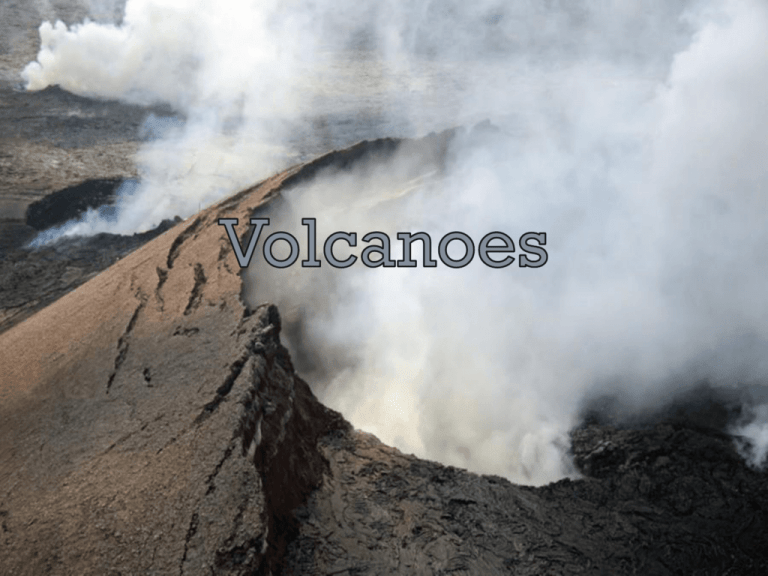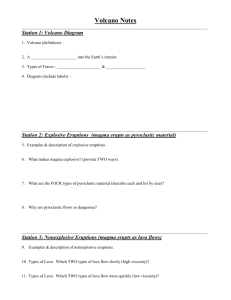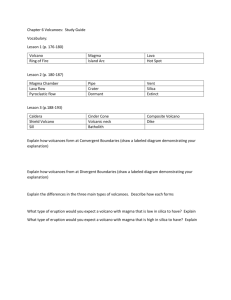Volcanoes
advertisement

• Despite the high temperature in the mantle, most of the layer remains solid due to extreme pressure – Magma: liquid rock produced under Earth’s surface • Melting Point: the temperature at which a substance will change from a solid to a liquid • Magma can form in three ways – Temperature rises above the melting point of rock – Pressure decreases lowering the melting point of rock – Addition of fluids, like water, can decrease the melting point • Volcanism: any activity that includes the movement of magma and gases toward or onto Earth’s surface – Magma rises because it is less dense than the surrounding rock • magma that flows onto Earth’s surface is called lava • Flows from an opening, or vent • When magma erupts from a volcano and then cools & hardens, it forms an igneous rock • Mafic: magma that • Felsic: magma that is rich in is rich in feldspar magnesium and and silica iron – Light in color – Dark in color – Makes up – Makes up oceanic continental crust and continental crust only • Viscosity: resistance to flow –Affects the force with which a particular volcano will erupt • Quiet Eruptions –Form from mafic magma –Low viscosity –Occur with oceanic volcanoes –Magma “oozes” out of the vent • When mafic lava cools rapidly, a crust forms on the surface of the flow • If the lava continues to flow after the crust forms, the crust wrinkles – Pahoehoe: a volcanic rock that forms from hot fluid lava • As it cools it forms a smooth, ropy texture • Means “ropy” in Hawaiian • If the crust deforms rapidly, or grows too thick to form wrinkles, the surface breaks into jagged chucks – Aa: a jagged volcanic rock that forms from lava that • has the same composition as pahoehoe – Blocky Lava: a volcanic lava that has a high silica content, and is highly viscous • Explosive Eruptions –The felsic lavas of continental volcanoes tend to be cooler and stickier than the fluid lavas produced by oceanic volcanoes • Pyroclastic material: fragments of rock that form during a volcanic eruption • What are the differences between an explosive eruption and a quiet eruption? • Volcanoes are usually located at the edge of plate boundaries – Ex: A major zone of active volcanoes encircles the Pacific Ocean • Known as the Pacific Ring of fire – Subduction zones • Continental-oceanic convergent boundaries • Oceanic-Oceanic convergent boundaries • The largest amount of magma is found at divergent boundaries along midocean ridges – The magma erupts to form underwater volcanoes • These volcanoes produce pillow lava • Shield Volcanoes: volcanic cones that are broad at the base and have gently sloping sides – Covers a wide area – Generally forms from quiet eruptions – Layers of hot, mafic lava flow out around the vent, harden, and slowly build up to form the cone – Ex: Hawaiian Islands • Cinder Cones: a volcano that has a very steep slope – Not usually tall- max height is not more than a few hundred meters – Form from explosive eruptions and are made of pyroclastic material • Composite Volcanoes: made of alternating layers of hardened lava and pyroclastic material – Quiet eruptions deposits lava and an explosive eruption follows depositing ash – Also known as stratovolcanoes – Develop to form large volcanic mountains • Caldera: a large, circular depression that forms when the magma chamber below a volcano partially empties and causes the ground above to sink – Calderas may fill with water to form lakes • Ex: Mount Mazama in Oregon (known as Crater Lake) • Hot Spot: an area of volcanic activity within the interior of a tectonic plate – Magma rises from the mantle in the middle of a plate, and not at a plate boundary – The rising magma creates a volcano, producing an island – As the plate shifts over the magma, a new volcano and new island is formed – Continues creating a chain of islands • Ex: Hawaiian Islands








